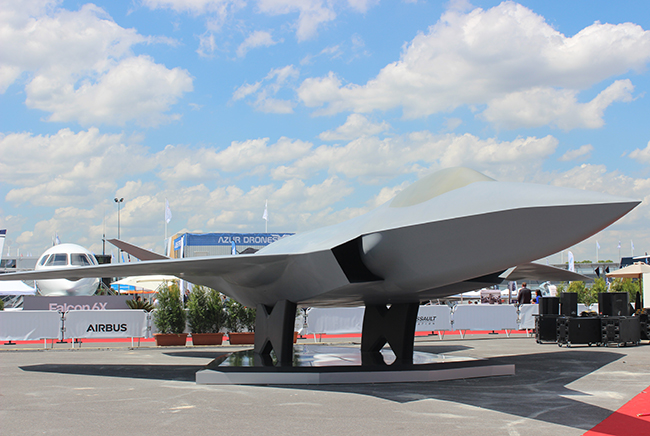
France, Germany, and Spain on June 17 unveiled this model of the "New Generation Fighter," part of its future combat air system. The aircraft is a joint venture between Dassault Aviation and Airbus. Staff photo by Brian Everstine.
LE BOURGET, France — The world’s largest air show kicked off with France, Germany, and Spain pulling the cover off the New Generation Fighter, a concept that will be jointly designed by Dassault and Airbus as part of the three countries’ future combat air system.
The ceremonial unveiling comes one year after the United Kingdom unveiled its next-generation fighter, known as Tempest, at the Farnborough Air Show.
USAF leaders said June 17 that while they know little about the New Generation Fighter or the Tempest, they welcome some competition on the global stage of advanced combat aircraft, even though the US continues to shop the F-35 to allies.
“Writ large, competition is a good thing,” Will Roper, the Air Force’s assistant secretary for acquisition, told reporters at the Paris Air Show, adding the US has a “fifth-generation system to be proud of” in the F-35.
French President Emmanuel Macron helped celebrate the unveiling of the new fighter, with the military leaders of the three countries also signing a framework to collaborate on the jet. France, Germany, and Spain are not part of the F-35 program.
This new fighter, along with the United Kingdom’s Tempest, are a “mockup” at this point and USAF leaders haven’t seen enough technical details to be able to classify them as possible “sixth-generation” aircraft or fifth generation to compete directly with the F-35.
“You need to take a look at what’s available right now,” Acting Air Force Secretary Matt Donovan said. “The F-35s are deployed to the European theater right now. When they’re developing new technologies, of course we want to encourage and we want to collaborate. But how long is it going to take? There are fifth generation planes like the F-35 [that are] operational and flying right now.”
Even if these countries move forward on air airframe different other than the F-35, there is still a chance to collaborate on the aircraft’s subsystems.
“We’re very interested in working with allies and partners, working on networking and data sharing,” Roper said.
When the UK first unveiled its Tempest mockup, “all we said was: ‘Hey, this is great. We’d just like to cooperate with you and collaborate with you,’” Donovan said. “That’s always a good thing, to share … advanced technology between friends and allies,” he added, noting it’s “absolutely important for future interoperability if we’re going to go to war as coalitions, which we always do.”